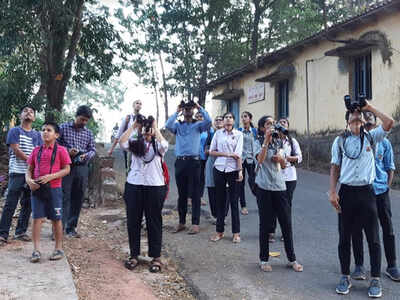
MANGALURU: St Aloysius College, a 140-year-old campus, spread over 37 acres, participated in the four-day Campus Bird Count (CBC) held from February 14.
Campus bird count (CBC) is a sub-event of the larger ‘Great Backyard Bird Count’ (GBBC), organised by Bird Count India in collaboration with eBIRD, since 2015. This is an effort to document bird life in various campuses across India. This year, 252 campuses took part. St Aloysius college recorded birds for the second consecutive year. The event was organised by the department of zoology and led by Vineeth Kumar K, assistant professor, department of zoology. Dr Hemachandra, HoD, zoology, was present. About 45 students from various undergraduate science, arts and commerce departments of the college participated.
The birding event concluded by recording 35 species of birds. The common most birds of the campus include black kite, Brahminy kite, feral pigeons, chestnut-tailed starlings, Asian koels and white- cheeked barbet. A total six migratory bird species were reported from the campus, which includes Blyth’s reed warbler, green warbler, large billed leaf warbler, Indian paradise flycatcher, blue-tailed bee-eater and ashy drongo.
The campus being in the midst of a crowded coastal city is home to several bird species, which is a rare and interesting observation. This emphasizes the importance of green patches in an urbanised area. The campus has several small green patches with large woody trees which act as sheltering grounds, additionally, there are many flowering and fruiting plants in the campus which attracts many birds as they provide food to these birds. There are hundreds of black kites seen perched on top of various buildings in the campus. Calls of Asian koels and white-cheeked barbets can be heard throughout the day. Flocks of hundreds of chestnut-tailed starlings flying around the campus is a blissful sight to cherish, said Vineeth.
Such bird counts done for several years will give an understanding of how the bird populations are changing with time. Last year, the team had reported 38 species of birds. Restricted number of days for the bird count, and changing weather patterns could have influenced the species numbers, he added.
Campus bird count (CBC) is a sub-event of the larger ‘Great Backyard Bird Count’ (GBBC), organised by Bird Count India in collaboration with eBIRD, since 2015. This is an effort to document bird life in various campuses across India. This year, 252 campuses took part. St Aloysius college recorded birds for the second consecutive year. The event was organised by the department of zoology and led by Vineeth Kumar K, assistant professor, department of zoology. Dr Hemachandra, HoD, zoology, was present. About 45 students from various undergraduate science, arts and commerce departments of the college participated.
The birding event concluded by recording 35 species of birds. The common most birds of the campus include black kite, Brahminy kite, feral pigeons, chestnut-tailed starlings, Asian koels and white- cheeked barbet. A total six migratory bird species were reported from the campus, which includes Blyth’s reed warbler, green warbler, large billed leaf warbler, Indian paradise flycatcher, blue-tailed bee-eater and ashy drongo.
The campus being in the midst of a crowded coastal city is home to several bird species, which is a rare and interesting observation. This emphasizes the importance of green patches in an urbanised area. The campus has several small green patches with large woody trees which act as sheltering grounds, additionally, there are many flowering and fruiting plants in the campus which attracts many birds as they provide food to these birds. There are hundreds of black kites seen perched on top of various buildings in the campus. Calls of Asian koels and white-cheeked barbets can be heard throughout the day. Flocks of hundreds of chestnut-tailed starlings flying around the campus is a blissful sight to cherish, said Vineeth.
Such bird counts done for several years will give an understanding of how the bird populations are changing with time. Last year, the team had reported 38 species of birds. Restricted number of days for the bird count, and changing weather patterns could have influenced the species numbers, he added.
Trending Topics
LATEST VIDEOS
More from TOI
Navbharat Times
Featured Today in Travel
Get the app







